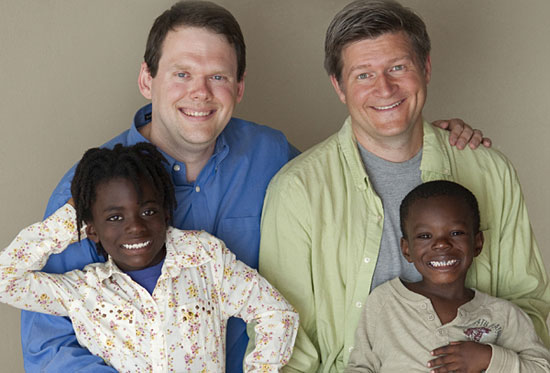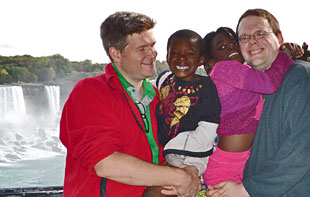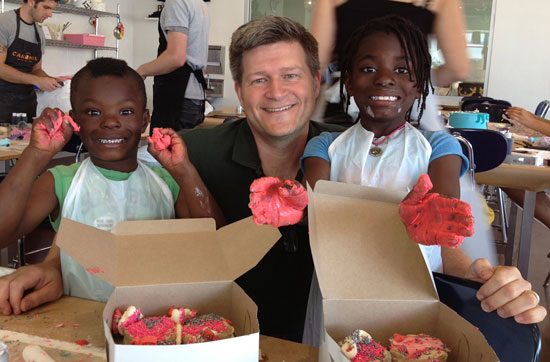Dad pride
June 13, 2013
As we prepare to celebrate our nation’s dads this weekend, how’s this for a heroic (not to mention exhausting) feat of fatherhood? For three consecutive months in mid-2005, Los Angeles County social workers delivered three tiny foster children to a couple who’d once tucked away any hope of being parents.
The oldest of the children was 18 months. The middle one was 4 months. And the youngest had been in the world for just 3 days.
“We made it through that glorious summer, a scorcher without air conditioning,” says John Ireland, as he recalls the diapers and feedings and joys of it all. “It was such a tremendous, intensive parenting experience”—one made even more complicated by the demographics of the household. For there were two men of the house, “Dad” and “Daddy.” John is married to Duncan Ireland, his partner of 20 years.
Like many gay men, John, 42, says he’d come to believe the subtle and overt messages in society that parenthood was out of reach for people like him. His own parents, he says, “let go” of their hopes of having grandchildren through him after he “came out.”
But all that changed, John says, after he and Duncan talked to social workers from L.A. County’s Department of Children and Family Services and the Southern California Foster Family & Adoption Agency during an informational fair at Plummer Park in West Hollywood.
“We were not only welcomed, we were actively recruited,” John says, noting that he and Duncan, 40, promptly underwent nine training sessions for certification as foster parents. That training included an emphasis on family transparency. “What they need is honesty. You don’t avoid any topics with a foster child,” says John, who was wed to Duncan in 2008, before California voters banned same-sex marriage through Proposition 8, which is under review by the U.S. Supreme Court.
In all, the couple provided foster care to four children, eventually adopting a sister and brother, now 8 and 5, respectively. “We would have adopted them all, if we could have,” says John, a consultant and fundraiser for non-profit groups who served as the stay-at-home dad while Duncan continued his law practice. Today, John helps lead an organization called Raise A Child, which works with the county and others to spread the word about opportunities for gays and lesbians to become foster and adoptive parents.
County child welfare officials know that some people may not approve of the government actively seeking gay and lesbian parents. But those officials say the county needs every willing and qualified adult possible to provide a safe and caring environment for the more than 16,000 foster youth who must be removed from dangerous homes.
“We need to recruit everyone who can help us”—including lesbian, gay, bisexual and transgender couples and individuals—says DCFS supervising children’s social worker Bryan Miller. “The LGBT community has been an underutilized resource for many years. We’re just catching up.” Miller says a UCLA study last year concluded that foster children do equally well when placed with gay, lesbian or heterosexual parents.
As for the critics, Miller offers this challenge: “If you’re going to complain, I want to see you at our next foster/adoption orientation.”
In recent years, the county’s foster care system has come under intense scrutiny and criticism for sometimes failing to protect the welfare of children living in group or individual homes. Just this week, the Board of Supervisors voted to end a decades-long relationship with Teens Happy Homes amid allegations of financial improprieties and child abuse detailed in the Los Angeles Times. But what rarely rises to the surface are the many profound and touching stories of success. As John explains: “These victories are small and only celebrated by those of us observing them happen.”
The experiences of John and Duncan, both as foster and adoptive parents, deserve a wider celebration.
As foster parents, John says, you’re trained to brace for the reality that the children you’ve grown to love may be reunified with relatives. That’s what happened with two of those first three youngsters to enter the couple’s life in rapid succession—Marisol and her infant brother, Isaías. Five months after coming to the Ireland home, the children were adopted by an aunt living near Staples Center in downtown Los Angeles. “We thought we’d never see them again,” John recalls.
When he and Duncan arrived at the aunt’s apartment, siblings in tow, she asked whether they had a keepsake photograph of the children and their foster parents. In fact, John had stashed a framed picture in their suitcase. He dug it out and handed it to her. To the men’s astonishment, she removed an image of the Virgin Mary from a wall and replaced it with the new photo.
“You are part of their lives and we want you to be part of our family,” she told them, a vow to which she’s stayed true during the past eight years by inviting the couple to birthday parties and other special occasions. “That was the best thing for those children,” John says in hindsight. “It worked exactly as the foster system was meant to be.”
As for baby No. 3, Emma, the couple adopted her in late 2005, six months after she first came to their home. And she remained an only child for nearly seven years, until John got a mid-morning call while driving along Laurel Canyon Boulevard. “Pull over and turn off the car,” an excited social worker advised. Emma’s 4-year-old brother, she reported, had entered the foster care system. Little Giovanni, who joined the family as a foster child in July, 2012, was adopted last month.
“He was so excited about being adopted,” John says, “that for two weeks when he woke up in the morning he’d ask: “Am I still a foster kid?” I’d tell him, ‘Nope, you’re no longer a foster kid.”
John is under no illusions that his family choices will be widely embraced, especially by those outside “the bubble” of Los Angeles. Not only are there two dads, but they’re white with African American children. “We don’t walk into a restaurant undercover,” he joked.
Asked what unique challenges gay couples confront, John says: “The biggest challenge is helping our kids navigate a society that is very focused on us. The spotlight is trained on our families. It’s still very controversial in our culture for gays and lesbians to parent.”
“The hardest part,” he continues,”is when we go into public. The kids are old enough to see the looks or be posed the questions in school. ‘Why do you have two dads?’ We have to prepare them to answer those questions.”
Two weeks ago, he says, he and his husband took the youngsters to a gay pride festival in the Antelope Valley. Along the road to the fairgrounds were protest signs warning, “Homo sin. Turn back.”
“How do you prepare a 5-year-old or an 8-year-old for that? We tell them that people have the right to express themselves. Some people do not agree with our family. Some people do not like families with only one parent.…The truth is that every kid has something they can be picked on about. Kids need to be taught resilience.”
This Sunday, none of those questions or pressures will be in the air when John, Duncan and their two high-energy, toothy-grinned kids who love handball and running attend “The World’s Largest Gay Father’s Day Celebration,” which includes brunch and a children’s concert.
The event is sponsored by, among others, John’s Raise A Child group, the City of West Hollywood and the Pop Luck Club, an organization of gay dads, prospective dads and their families. John is the current president, with duties that include storing the club’s banners in his garage and making sure there’s plenty of Capri Sun juice boxes for monthly potlucks.
Says John: “I think I’m the luckiest guy in the world…besides my husband.”
Posted 6/13/13















 405 bridge work causes a stink
405 bridge work causes a stink

